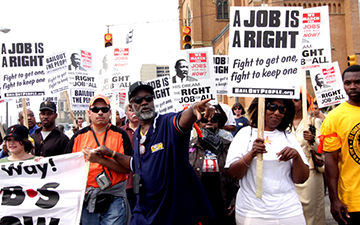
More and more labor leaders nationwide agree using social media sites such as Facebook, Twitter, YouTube and MySpace on the Internet these days is a groundbreaking way to reach and organize workers.
“Across the country, union members are using the new social media to mobilize workers and share information,” writes James Parks on the AFL-CIO’s Now Blog.
Darren DeMarco is the information technology director with the Electrical Workers (IBEW) and believes utilizing social media to reach workers is a strong complement to traditional forms of organizing.
“I think you have to use every tool out there to organize,” said DeMarco. “You have these tools out there where the user can very easily set up their own website, set up a Facebook page, reach out to friends and start a conversation with people they could not before.”
In his blog, Parks writes about Steve Selby, an organizer with IBEW in York, Pa., who urgently needed to reach 300 workers at a local Comcast office. Rather than stand outside the office each day passing out literature to workers, Selby decided to set up a MySpace account. Once the account was up and running Selby began handing out fliers directing the workers to his MySpace page in order to share important information with them.
Union activists are finding out that social media reaches more people faster and cheaper than many traditional forms of communication, writes Parks. For example the AFL-CIO live tweeted President Barack Obama’s address at the AFL-CIO convention recently.
AFL-CIO President Richard Trumka recently stated that union leaders need to reach out to young workers in particular and prioritize their important presence in the U.S. labor movement. Trumka said he values social media as a new tool to reach the next generation so that young people continue to fight for workers’ rights.
Last month Trumka was the keynote speaker at the Netroots Nation annual conference where progressive bloggers, journalists and activists come together to exchange ideas about how to be more effective when using modern technology to influence the public debate.
“When I was growing up, and working in the coal mines, I certainly wasn’t tweeting about it,” said Trumka.
“In just a few years you have grown into a new force in progressive politics and also in American journalism,” Trumka added. “We are seeing a revolution in communications and we face a big challenge to keep progressives at the head of the curve. Our successes, including this conference, gives us hope that we will,” said Trumka.
“Many of us in the labor movement have fretted over the death of the labor beat at newspapers across the country. But we are seeing today that your work in the blogosphere is the equivalent of letting a thousand flowers bloom.”
The AFL-CIO along with more than a dozen affiliated unions is reaching out to potential new members and educating current ones through social media sites such as Facebook, Twitter, MySpace and YouTube.
Many agree face-to-face contact and person-to-person handouts will always be an important part of organizing and sharing information with workers. But at the same time using new tools such as social media on the Internet can only help share that information and develop relationships with people on a massive scale at the click of mouse, activists say.
Using social media as well as face-to-face contact in spreading the good word about workers’ rights should complement each other and be utilized together to organize, labor leaders say.
Unions with a Facebook page or Twitter or both include: AFSCME, AFT, AIR Line Pilots (ALPA), American Federation of Television and Radio Artists (AFTRA), California Nurses Association/National Nurses Organizing Committee (CAN/NNOC), Electrical Workers (IBEW), Fire Fighters (IAFF), Painters and Allied Trades (IUPAT), Sheet Metal Workers (SMWIA), Transport Workers (TWU), UNITE-HERE, United American Nurses (UAN), and Unites Steelworkers (USW).
plozano@pww.org











Comments